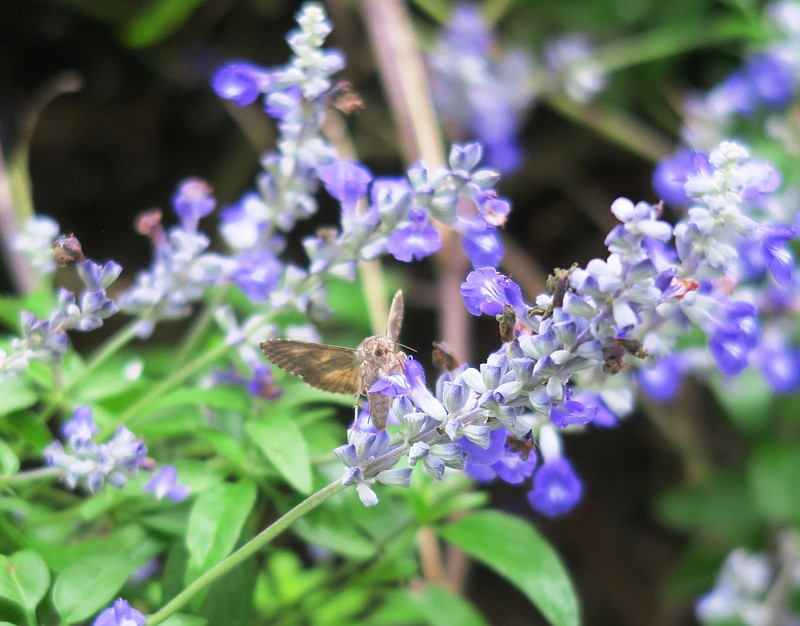When gardeners hear the world salvia, it can bring any number of plants to mind — the old-fashioned, red-spiked annual Salvia splendens, or a blue- or purple-flowering form, or maybe the herb you add to Thanksgiving dressing — sage (Salvia officinalis).
Salvia is the largest genus of plants in the mint family with more than 800 different types, from annuals and biennials to perennials and even some shrubby forms. Most are thought of as ornamentals, but the common culinary sage, Salvia officinalis, is a mainstay in many herb gardens, and the chia seeds sold as a culinary powerhouse are the seeds from Salvia hispanica.
Since all members of the salvia family are in the mint family, they all have square stems and aromatic leaves — some more so than others. Usually this aromatic trait makes them less attractive to wildlife, but that isn't always the case.
Most salvias thrive in full sun but will tolerate light shade. They do not fare well in poorly drained soil. Once established, they are quite drought tolerant but will appreciate supplemental watering when dry. Fertilize most of them monthly throughout the growing season.
Flower color can run the gamut from reds and pinks to shades of purple and blue, white and even some yellows. Leaves can be green or variegated, gray or silver.
While the ornamental types are usually grown for their flowers, a few are grown for their foliage form and texture. Silver sage (Salvia argentea) is often mistaken for lamb's ears with its soft, downy foliage. It is a relatively short-lived perennial.
FLOWERS WITH LIPS
The flowers can vary in color and size, but they are all genetically similar, with two lips — the top lip is usually erect and hooded, while the lower lip is wider and more open. The flowers are usually born in spikes of blooms, with some blooms densely clustered on the stems while others have more space between individual blooms.
Bloom time varies with the species. Some bloom spring or fall, while others bloom all summer. Bees, butterflies and hummingbirds adore the salvia blooms.
With so many salvias to choose from, and new introductions annually, it is hard to know which to choose. Mature size does vary from some annuals getting no taller than 12 inches to a few woodier specimens like the Salvia greggii, or cherry sage, which can reach 4 feet in height and width. Mexican bush sage (Salvia leucantha) is a perennial that dies back to the ground each year, but will grow up to 5 feet or more in one season and has large, velvet-like blossoms from late summer through fall.
In recent years, the Wish series of salvias has been generating a lot of interest. Developed in Australia with some of the proceeds going to the Make a Wish foundation in Australia, there are three that I have seen sold in Arkansas — "Love and Wishes." "Wendy's Wish" and "Ember's Wish." These plants bloom all summer and can get quite large.
Other popular perennial salvias include "Black and Blue" Salvia guaranitica, with deep blue and dark purple blooms; "Indigo Spires" with large purple spikes of blooms; Mealycup sage (S. farinacea), with a more compact growth habit, with options for blue ("Victoria Blue") or white ("Victoria White") flowering forms.
A common fall red-blooming salvia is Pineapple Sage (S. elegans). Two other red salvias are "Lady in Red" and the red and white "Hot Lips." Pink options include "Pink Profusion" and "Rockin Fuchsia."
CULINARY SAGE
While some gardeners may struggle trying to grow the culinary sage (S. officinalis), in my yard it thrives. I have both the common gray leafed variety, but also a yellow and green variegated form called "Aurea" and the "Tricolor" with green, white and purple foliage. I think they are as attractive as they are edible. They have lovely small purple bloom spikes in the spring.
The common gray form is in pitiful soil in full sun, and it spreads more vigorously every year. The others are in a raised herb bed.
Excellent soil drainage is a must for the culinary herb and is well appreciated by almost all salvia.
Salvias are rarely attacked by any insects or disease, and rarely eaten by deer or rabbits.
Most gardeners opt for the perennial salvias in the garden, but the old-fashioned spiked annual now comes in red, purple, white and pink shades. It will bloom all summer, provided it gets some fertilization, water, and the flowers are dead-headed after bloom.
Dead-heading is advisable for most salvias to keep them blooming as long as possible.
There is a salvia for every sun garden out there since there are so many colors and sizes available. They are versatile and can add color and interest in the spring or summer garden, but many explode with color for fall, a time when we often need some extra pick-me-ups in the garden.
Salvia can be propagated by seeds or cuttings, and the plants are easily divided in the spring or fall.
Read Janet Carson's blog at arkansasonline.com/planitjanet.

